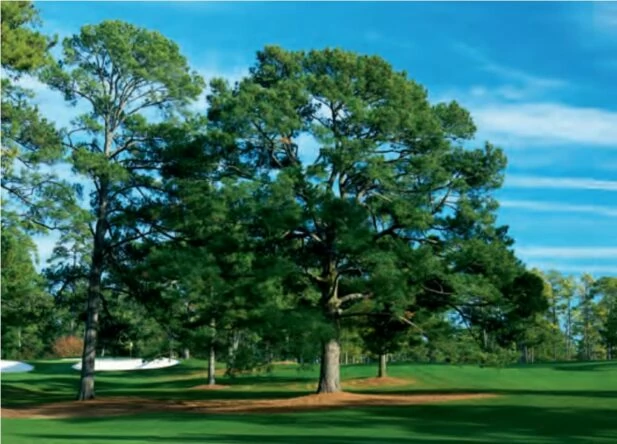Rae’s Creek
Named after John Rae, who died in 1789, Rae’s Creek flows at the back of No. 11 green and runs in front of No. 12 green and No. 13 tee. It was Rae’s house that was the farthest fortress up the Savannah River from Fort Augusta. The house kept residents safe during attacks when the fort was out of reach.
Ornamentals
“The big oak tree” on the golf course side of the Clubhouse is a live oak, Quercus virginiana. It was planted when the building was completed in the late 1850s, making the tree approximately 160-170 years old. Several other live oaks were planted on the grounds about the same time. The “big oak” is one of the favorite gathering places during the Masters Tournament.
The privet hedge at the Club was developed from plants imported from France by the Berckmans. There are thousands of miles of privet hedge in the South which were propagated from this original source.
The wisteria vine, Wisteria sinensis, most noticeable on the Aphananthe aspera tree next to the Clubhouse, is reported to be one of the first wisteria to be established in the US. It is also believed to be the largest vine of its kind in the country.
The most abundant tree at Augusta National is the pine. The predominant specie is the Loblolly Pine, Pinus taeda, with a scattering of Shortleaf Pine, Pinus echinata, and Slash Pines, Pinus elliottii. There are also several Longleaf Pines, Pinus palustris, and Eastern White Pines, Pinus strobus, found on the property. Many of the pines found in the original forested part of the course are over 150 years old (e.g., hole No. 10), while many others were planted when the course was built (e.g., hole No. 3). Azaleas and dogwoods are also in abundance. There are over 30 varieties of azaleas, several strains of dogwood and dozens of varieties of ornamental shrubs on the grounds.
Surprisingly, there are a few palm trees on the course. At one point during the course’s early years, hole No. 4 was called the Palm Hole.
Eisenhower Tree
Once located at hole No. 17, the Eisenhower Tree stood approximately 210 yards from the Masters tee and left-center of the fairway. The tree was removed in February 2014 following an historic ice storm that damaged most of the tree’s major branches. The loblolly pine was approximately 65 feet high and approximately 100 years old. The former President of the United States and Club member hit into the tree so often he campaigned to have it removed. At a Club’s governors meeting in 1956, Eisenhower proposed cutting the tree down. Clifford Roberts promptly ruled him out of order and adjourned the meeting. The pine was immediately linked to Eisenhower.




